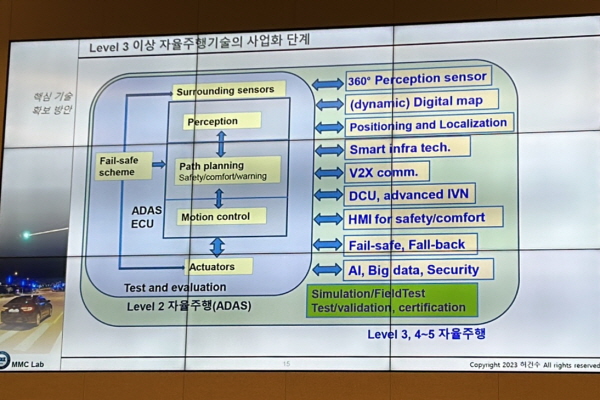자율주행 레벨3 이상의 핵심기술들이 모두 사업화 수준에 도달한 것은 아니기에 레벨2+의 기술 고도화와 레벨3 이상 자율주행을 위한 기술들의 지속적인 개발과 기술적 내재화가 필요하다는 전문가의 주장이 제기됐다.

▲허건수 한양대학교 미래자동차공학과 교수가 발표하고 있다.
크루즈 자율주행 14.5만km·韓 운전자 32.2만km 당 사고 1회 발생
레벨2+ 기술 고도화·레벨3 이상서 필요한 핵심 기술 개발해야 될 시기
자율주행 레벨3 이상의 핵심기술들이 모두 사업화 수준에 도달한 것은 아니기에 레벨2+의 기술 고도화와 레벨3 이상 자율주행을 위한 기술들의 지속적인 개발과 기술적 내재화가 필요하다는 전문가의 주장이 제기됐다.
허건수 한양대학교 미래자동차공학과 교수는 26일 앤시스와 모라이가 공동 주최한 KADF(Korea Autonomous Developer Forum) 2023에 기조연설자로 나와 자율주행 기술의 동향과 사업화 단계 진행에 대해 발표하며 레벨3 이상의 자율주행은 아직 타고 다닐 수준만큼 개발되지 않았다고 전했다.
사고 빈도수가 최근까지 자율주행 기술 안정성의 확보의 기준으로 여겨지는 가운데 크루즈는 약 14만5,000km 당 1번꼴로 자율주행이 디스인게이지먼트(이탈, 해제)됐다고 보고됐고, 보통 6.5만km 정도에 한 번 사고가 발생한다.
.jpg)
사람이 직접 운전할 때 미국 같은 경우는 약 80만km 한국은 약 32만km 당 교통사고 한 건이 발생한다.
아직 자율주행이 인간을 뛰어넘는 안정성을 보이지는 않고 있다는 결과다.
자율주행에서는 사고가 발생하지 않을 것이라는 기대와 달리 미국의 교통국에서 발표한 자료에 따르면 자율주행이 완벽하게 되더라도 사실 사람이 내는 교통사고의 한 3분의 1 정도 밖에 줄어들지 않을 것이라는 분석도 있다.
또한, 일본의 도요타도 미국에 레벨2가 100% 다 적용되더라도 교통사고는 50% 정도만 줄어들 것이라 분석했다.
현재 자율주행 업계에서는 인간이 교통사고를 내지 않는 상황에서 자율주행도 교통사고를 내지 않는다는 보장이 있는지에 대해 확실한 답을 내놓고 있지 못하고 있으며 테슬라가 이런 고민을 해결하려 인간 운전자의 판단과 자율주행에서의 판단과 패턴을 지속적으로 분석을 하고 있다.
자율주행 사업 방향에 대해 허 교수는 레벨2 기술들이 하나씩 도입되면서 레벨2를 고도화하는 쪽으로 사업하는 것이 적절한 비즈니스 모델이라 예상되며 레벨2+ 기술 고도화나 3이상에 필요한 핵심 기술을 꾸준히 개발해야 될 시기라고 전했다.
GM은 슈퍼 크루즈라는 레벨2에서 울트라 크루즈라는 레벨2+의 기능을 고도화하고 있으며 둘의 차이는 레벨2+에서는 레벨2와 다르게 라이다와 맵 데이터를 활용한다는 것이다.
도요타도 도전적으로 레벨2+를 지금 추진하고 있으며 정밀지도를 사용하고 360도를 커버하는 센서 유닛으로 레벨2+를 구현을 하려고 노력 중이다.
허 교수는 레벨3에 대해서는 비판적인 시각으로 바라봤다.
메르세데스-벤츠의 레벨3 자율주행은 시속 60km의 제한이 있으며 비, 눈과 같이 날씨에 영향을 받고, 터널에서도 정상작동이 어렵다.
결국 레벨2+를 추진하고 있는 메이저 OEM들의 사양과 메르세데스-벤츠가 말하는 레벨 3의 사양이 차이가 거의 없다는 것이다.

어느 순간에서도 자율주행 기능을 잃으면 안 되며 위 그림의 오른쪽에 있는 모든 기술들이 완벽하게 시너지를 이뤄야 하는 레벨3, 4, 5는 아직까지는 기술적으로 굉장히 넘어야 할 산이 많이 있다는 것이 허 교수의 주장이다.
허건수 교수는 “인간보다 안전한 자율주행차를 만드는 것은 매우 어려운 일이며 레벨3에 해당하는 자율주행차를 판매하기에는 부족한 부분이 많다”라며 향후 최소 5년 동안은 레벨2+의 고도화와 같은 상황이 계속될 것이라 예상했다.

.jpg)
